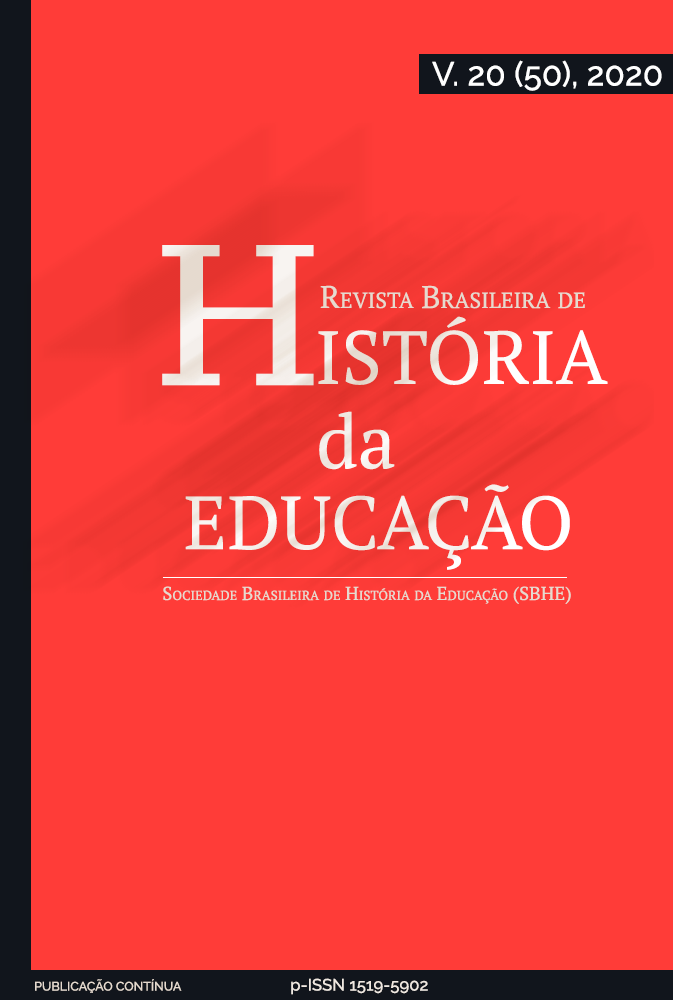"O espírito do povo": estética, professores e folclore na Argentina na década de 1920
Resumo
A década de 1920 foi extremamente rica em termos de processos e problemas de relevância singular e também foi uma década prolífica em termos de debates e geração de novas propostas. O clima social do pós-guerra colocou em crise os preceitos mais racionalistas que o liberalismo do século XIX havia instalado e levou à inclusão de formas de conhecimento ligadas ao espiritual e à sensibilidade, além da preeminência da razão. Para explorar algumas das prioridades educacionais, nos deteremos na análise da Pesquisa Nacional de Folclore ou Pesquisa de Ensino, realizada em 1921 e cujos resultados foram reunidos na ‘Colección de Folklore’. Foi uma iniciativa para a qual os professores das escolas nacionais de todo o país foram contratados para coletar os elementos folclóricos que encontravam em sua jurisdição: crenças e costumes, narrativas e ditados, arte e ciência popular para aprender e prescrever ‘O espírito do povo’
Downloads
Referências
Blache, M. (1992). Folklore y nacionalismo en la argentina: su vinculación de origen y su desvinculación actual. Revista Runa, 20(1), 69-89.
Blumenberg, H. (1986). The legitimacy of the modern age. Cambridge, UK: Cambridge University Press.
De Miguel, A., De Biaggi, M. L., Enrico J., & Román M. S. (2007). Normalismo, cultura letrada y resistencia de la oralidad en la historia de la lectura y la escritura en Argentina. Ciencia, Docencia y Tecnología, 18(34), 97-127.
Dupey, A. M. (1998). La siempre vigente Encuesta de Folklore del año 1921. Revista de la Escuela de Antropología, 4, 9-16.
Encuesta, Carpeta de Chaco. Documento antiguo sin más información.
Encuesta, registro de Villa Excelsior, Santos Lugares. Documento antiguo sin más información.
Funes. P. (1999). Letras nacionales nacidas en vientre de leona. Literatura y nación en Argentina y Uruguay, 1910-1930. Estudios Sociales. Revista Universitaria Semestral, (17), 14.
Funes. P. (2006). Salvar la nación: intelectuales, cultura y política en los años veinte latinoamericanos. Buenos Aires, AR: Prometeo.
Marechal, L. (1928). Ideas sobre el alcance de la educación estética en la escuela primaria. El Monitor de la Educación Común, 47(667), 415-416. Recuperado de: http://www.bnm.me.gov.ar/ebooks/reader/reader. php?mon=1&vt=n&dir=909000&num_img=415.
Prieto, A. (1988). El discurso criollista en la formación de la Argentina moderna. Buenos Aires, AR: Sudamericana.
Pulfer, D. (2010). Rojas: educación y cuestión nacional en el centenario: introducción a la reedición de La Restauración Nacionalista. La Plata, AR: UNIPE.
Ramos, J. P., & Córdoba, P. (1921a). Folklore argentino: instrucciones a los maestros. Buenos Aires, AR: Consejo Nacional de Educación.
Ramos J. P., & Córdoba P. (1921b). Instrucciones para los maestros. El Monitor de la Educación.
Rancière, J. (2011). El tiempo de la igualdad: diálogos sobre política y estética. Barcelona, ES: Herder.
Rojas, R. (1922). La Restauración Nacionalista. Buenos Aires, AR: Edic. de La Facultad.
Sarlo, B. (2007). Una modernidad periférica: Buenos Aires 1920 y 1930. Buenos Aires, AR: Nueva Visión.
Southwell, M. (2011). Articulaciones entre estética y pedagogía. Trabajo docente y sensibilidad en la década del 1920, Argentina. In Ponencia presentada en la 33ª International Standing Conference for the History of Education / ISCHE (p. 1-15). San Luis Potosí, MX.
Terán, O. (2004). Ideas en el siglo. Intelectuales y cultura en el siglo XX latinoamericano. Buenos Aires, AR: Siglo XXI-Fundación OSDE.
Villavicencio, S. (2010). Sarmiento y la nación cívica. Amérique Latine Histoire et Mémoire. Les Cahiers ALHIM, 19. Recuperado de: http://alhim.revues.org/3511
Copyright (c) 2020 Myriam Southwell (Autor)

This work is licensed under a Creative Commons Attribution 4.0 International License.
Os direitos autorais pertencem exclusivamente aos autores. Os direitos de licenciamento utilizados pelo periódico consistem na licença Creative Commons Attribution 4.0 (CC BY 4.0): são permitidos o acompartilhamento (cópia e distribuição do material em qualqer meio ou formato) e adaptação (remix, transformação e criação de material a partir do conteúdo assim licenciado) para quaisquer fins, inclusive comerciais.
Recomenda-se a leitura desse link para maiores informações sobre o tema: fornecimento de créditos e referências de forma correta, entre outros detalhes cruciais para uso adequado do material licenciado.













